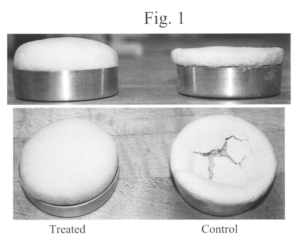Patent a Recipe?
Recently there have been many inquires about patenting a recipe. Many of these inquires are related to the new California law legalizing marijuana that has inspired many entrepreneurs. However, a recipe is patentable only if the recipe meets certain narrow criteria.
Recipe Must Be Novel and Non-Obvious
All inventions must be both novel and non-obvious to be entitled to patent protection. In the context of a recipe “novel†means that the invention cannot be a pre-existing recipe — that is, it cannot be a recipe that has been handed down, the inventor must invent the recipe! To be “non-obvious†the recipe cannot be an obvious improvement or alteration of a previously known recipe.
This means that there must be some unusual or unexpected outcome.

Most new recipes are merely combinations of known ingredients in varying amounts. They are simply variations of known recipes. To be patentable, however, the resulting food product must have some unexpected feature, or the process for making the food product must be novel and unique.

For example, US patent number 8,088,427 discloses a system for making gluten-free bread products. This patent teaches the use of ingredients that might make one re-consider whether to eat this particular gluten-free bread.*Â The U.S. Patent & Trademark Office found that the process for producing the gluten-free bread was novel and non-obvious, and a patent was granted on this method.
On the other hand, if the inventive step is to add a new ingredient and the new ingredient produces an expected result, then the resulting food product is “obvious†and will not be patentable.
* The first claim is for a gluten-free bread product comprising a starch, a gluten-free gas-retaining polymer selected from the group consisting of butadiene-styrene rubber, butyl rubber, paraffin, petroleum wax, polyethylene polyisobutylene, polyvinyl acetate, poly-1-vinylpyrrolidone-co-vinyl acetate copolymer, polyvinyl alcohol, polyethylene glycol, polyethylene oxide,polyacrylic acid, Sapotaceae, Apocynaceae, Moraceae, Euphorbiaceae, and a gluten-free setting polymer selected from the group consisting of polylacticacid, polyvinyl alcohol, corn zein, and polycaprolactone, said bread product having a specific volume of about 4.0cc/g to about 6.0 cC/g.
Trade Secrets Can Be Used to Protect Food Products
A patent may not be the best way to protect a food product because patent applications and issued patents are published. After publication, anyone can learn the details of any recipe disclosed in a patent application. Some companies, like Coca-Cola, have chosen to use trade secrets to protect their recipes. A trade secret provides different protection than patent protection in a number of ways. With trade secrets, inventors do not disclose the ingredients of the food product, or how to make the product. Instead, employees and others must sign non-disclosure agreements preventing them from disclosing the confidential information contained in the recipe. Unlike patent protection, a trade secret cannot be used to prevent a third party from making the same food product if the third party independently discovers the product, or if the third party reverse-engineers the product.
This blog is made available by Adams Law Office for educational purposes only to convey general information and a general understanding of the law, and not to provide specific legal advice. By using this blog you acknowledge there is no attorney-client relationship between you and Adams Law Office. This blog should not be used as a substitute for competent legal advice from a licensed professional attorney applied to your circumstances.
